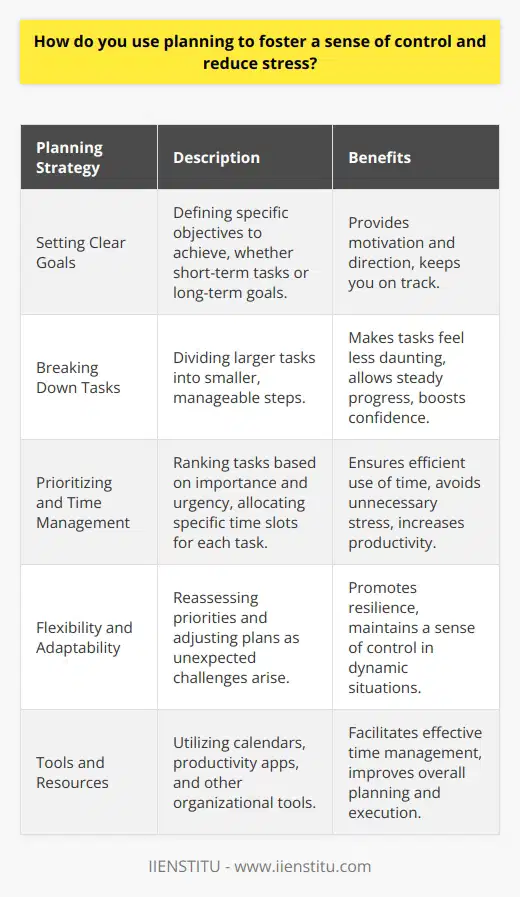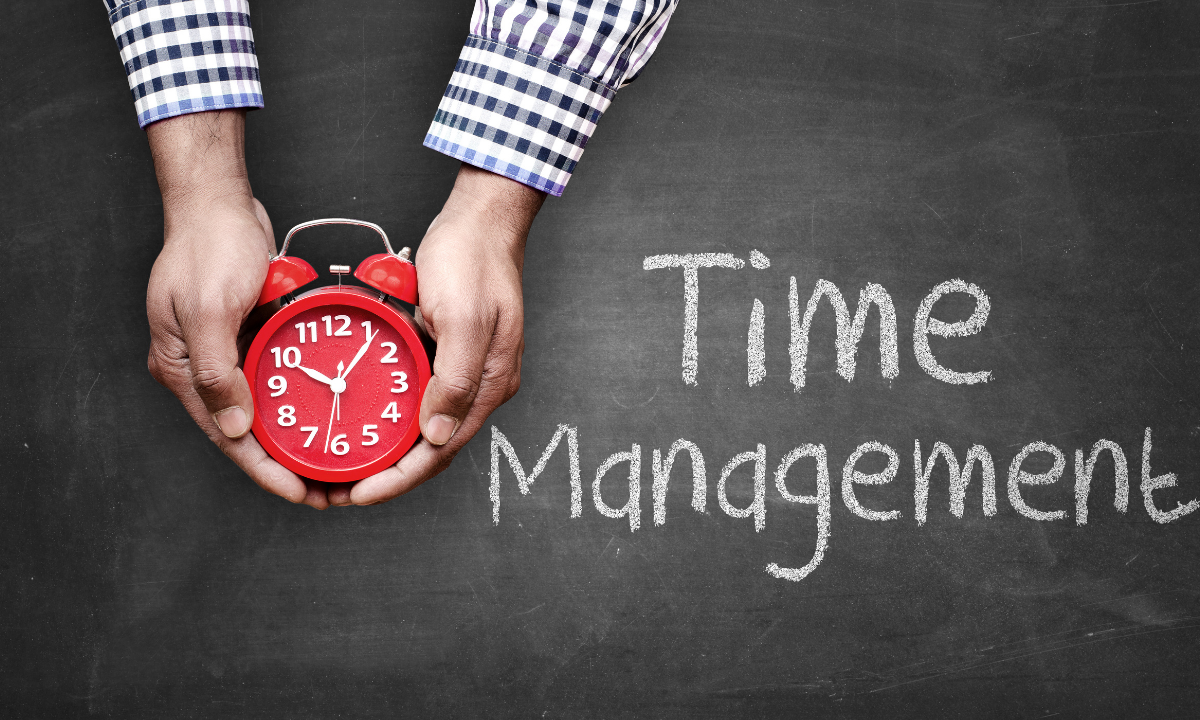
The question "How Crucial Is Planning In Your Time Management Routine?" is frequently posed during job interviews to gauge the prospective employee's ability to organize tasks, prioritize work, and meet deadlines. It suggests the interviewer's emphasis on time management skills, which are pivotal in today's fast-paced work environment.
Related Course: Time Management Training Course
The question helps the interviewer understand how well the candidate can manage their workload, how effectively they can plan their job, and their ability to optimize productivity.
The Purpose of the Question: How Crucial Is Planning In Your Time Management Routine?
The purpose of this question is to evaluate the candidate's planning abilities and their capacity to integrate planning into their time management routine.
Interview Question: Which Time Management Techniques Help Against Procrastination?
Interview Question: What Relaxes You During Stressful Times?
It helps to discern how proactively the candidate organizes their tasks, balances their professional and personal life, avoids procrastination, and overcomes challenges that might interfere with their productivity.
In essence, the question helps determine the candidate’s level of responsibility, stress-resistance, and commitment to setting and achieving professional goals.
At What Interview Level Is this Question Asked?
This question is generally asked at various levels of employment interviews, from entry-level to executive roles. Regardless of the job position, efficient time management and effective planning are required for all employees to thrive in a dynamic work environment.
It's particularly crucial for managerial and leadership roles, as these positions require overseeing projects, meeting deadlines, and ensuring their team stays on track.
Related Course: Leadership Course
What Kind of Answer Is Expected from the Candidate?
A comprehensive answer to the question "How Crucial Is Planning In Your Time Management Routine?" should exhibit your proficiency in managing time and integrating planning into your everyday work routine.
Employers typically expect an answer illustrating your ability to balance tasks, prioritize, and maintain efficiency under pressure. It is an opportunity to highlight your ability to juggle numerous responsibilities and showcase your problem-solving skills when faced with time constraints. Presenting concrete examples from your previous work experiences where you successfully managed time through careful planning would also add credibility to your answer.
Possible Answers to Consider
When addressing the question, consider highlighting how planning plays a critical role in your time management routine.
For instance, you might say,
"Planning is crucial in my time management routine because it helps me structure my workday. I typically start my day by jotting down the tasks I need to accomplish; I prioritize them based on their urgency and relevance. It ensures that I focus on tasks that are integral to my role. I often use digital tools and strategies to keep track of my deadlines, ensuring that I meet them reliably."
Ensure that your comprehension of the importance of planning in your time management routine is evident in your answer. Emphasize planning as the backbone of time management, the instrument that helps you synchronize your obligations, maximize productivity, and maintain a healthy work-life balance.
In conclusion, the question "How Crucial Is Planning In Your Time Management Routine?" is an opportunity to distinguish yourself as a competent professional capable of navigating dense workloads effectively.
It encourages you to represent your time management skills as a strength during your interview. As with any skill, effective planning in your time management routine can be honed with practice — so, seize every opportunity to do so.
Impact of Planning on Time Management Efficiency
Comparison of Task Completion with and without Time Planning
Relation Between Planning and Time Management in Achieving Objectives
Similar interview questions:
On a scale from 1 to 10, how significant do you consider planning in managing your time effectively?
Do you perceive planning to be a critical aspect of your time management routine?
In the context of managing your time, how important is planning to you?
What impact does planning have on your time management routine?
In your daily time management routine, is planning a key component?
How heavily do you rely on plans to manage your time efficiently?
Can you share your thoughts on the importance of planning in time management?
Do you believe that your time management routine would suffer without proper planning?
What role does planning play in how you manage your time?
In your opinion, would your time management be less efficient if planning was removed from the equation?
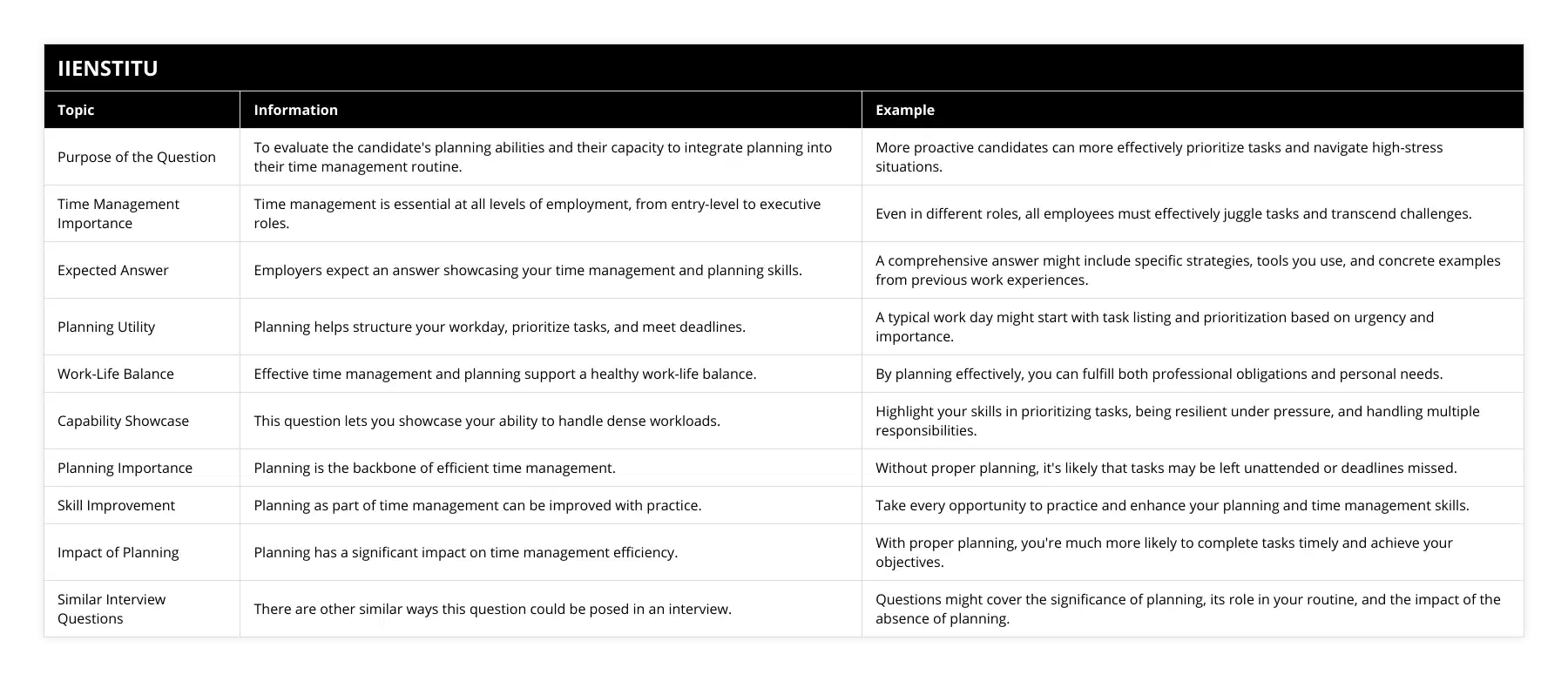
Frequently Asked Questions
How do you prioritize tasks in your daily schedule?
When it comes to prioritizing tasks in my daily schedule, I always start by assessing the urgency and importance of each task. I ask myself, "What needs to be done first to meet deadlines and achieve my goals?"
Making a To-Do List
Every morning, I make a to-do list of all the tasks I need to complete that day. I find that writing things down helps me stay organized and focused. Plus, there's something satisfying about crossing items off the list as I finish them!
Prioritizing Urgent and Important Tasks
I prioritize tasks based on their urgency and importance. Urgent tasks are those that need immediate attention, like responding to a client's email or meeting a project deadline. Important tasks may not be as time-sensitive but are critical to achieving long-term goals, like working on a new business proposal or learning a new skill.
Breaking Down Big Projects
When I have a big project on my plate, I break it down into smaller, manageable tasks. This helps me avoid feeling overwhelmed and ensures that I'm making steady progress. I set mini-deadlines for each task to keep myself accountable.
Staying Flexible
While having a plan is important, I also try to stay flexible. Unexpected things can pop up during the day, and I need to be able to adjust my priorities accordingly. If something urgent comes up, I'll shift my focus to address it before returning to my original schedule.
At the end of the day, prioritizing tasks is about being strategic and adaptable. By focusing on the most critical tasks first and staying organized, I'm able to maximize my productivity and achieve my goals.

What strategies do you use to manage your time effectively?
I have developed several strategies to manage my time effectively and ensure that I meet all my deadlines. One of the most important techniques I use is prioritizing my tasks based on their urgency and importance. This helps me focus on the most critical tasks first and avoid wasting time on less essential activities.
Planning and Scheduling
Another strategy I employ is planning and scheduling my tasks in advance. Every morning, I take a few minutes to review my to-do list and allocate specific time slots for each task. This helps me stay organized and ensures that I have enough time to complete all my responsibilities.
Breaking Tasks into Smaller Chunks
When faced with large projects, I break them down into smaller, manageable chunks. This makes the project less overwhelming and allows me to make steady progress towards completion. I also set mini-deadlines for each chunk to keep myself accountable and on track.
Minimizing Distractions
To maintain focus and productivity, I actively work to minimize distractions. I silence my phone notifications, close unnecessary browser tabs, and find a quiet workspace when I need to concentrate on important tasks. These small changes have made a big difference in my ability to stay focused and manage my time effectively.
Continuous Improvement
Finally, I believe in continuously improving my time management skills. I regularly reflect on my work habits and seek feedback from colleagues and supervisors. By identifying areas for improvement and implementing new strategies, I have been able to refine my approach to time management over time.
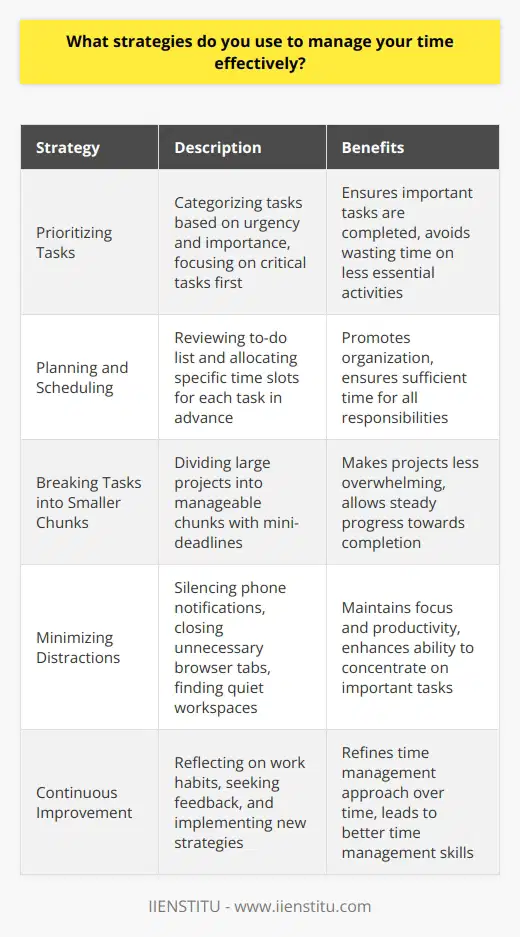
How do you handle unexpected disruptions to your planned schedule?
Unexpected disruptions are a part of life, and I've learned to handle them with flexibility and adaptability. When faced with a sudden change in my schedule, I take a moment to assess the situation and determine the best course of action.
Prioritize and Communicate
First, I prioritize my tasks based on urgency and importance. If necessary, I communicate with my team or supervisor to discuss any adjustments that need to be made. Open communication is key to ensuring everyone is on the same page and working towards the same goals.
Stay Calm and Focused
In the face of unexpected disruptions, I remain calm and focused. I once had a project deadline suddenly moved up by a week due to a client's request. Instead of panicking, I took a deep breath, broke down the tasks into manageable chunks, and dove in. By staying level-headed, I was able to complete the project on time and exceed the client's expectations.
Embrace Flexibility
I believe that embracing flexibility is crucial when dealing with unexpected disruptions. I'm always ready to adapt my approach or find creative solutions to keep things moving forward. For example, when a team member called in sick during a critical phase of a project, I stepped in to cover their responsibilities and collaborated with the rest of the team to ensure we met our goals.
Learn and Grow
Every disruption is an opportunity to learn and grow. I take the time to reflect on how I handled the situation and identify areas for improvement. This helps me become more resilient and better prepared for future challenges.
In summary, I handle unexpected disruptions by prioritizing, communicating, staying calm, embracing flexibility, and learning from each experience. By approaching these situations with a positive attitude and a solution-oriented mindset, I'm able to navigate through the challenges and deliver results.
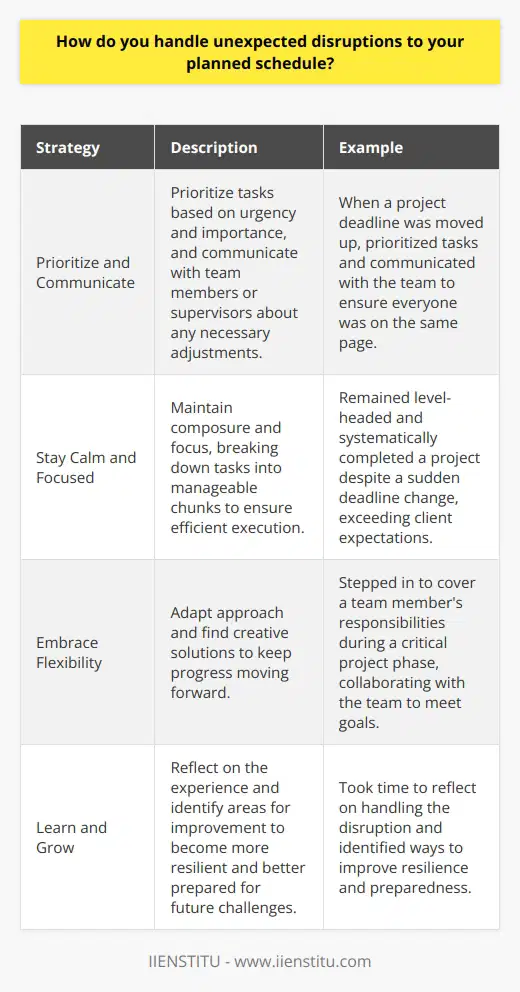
What role does goal-setting play in your time management approach?
Goal-setting is an essential part of my time management approach. I believe that clear, achievable goals provide direction and motivation, helping me stay focused and productive.
Breaking Down Goals
I like to break down larger goals into smaller, manageable tasks. This makes the overall goal less daunting and allows me to track my progress more easily. I find that celebrating small wins along the way keeps me energized and committed to the end result.
Prioritizing and Adapting
When setting goals, I prioritize based on importance and urgency. I'm not afraid to adjust my goals if circumstances change or if I realize I've taken on too much. Being flexible and realistic helps me avoid burnout and ensures I'm always working towards what matters most.
Staying Accountable
I hold myself accountable by regularly reviewing my goals and assessing my progress. If I'm falling behind, I'll reevaluate my approach and make changes as needed. I also find that sharing my goals with others, like colleagues or mentors, provides an extra layer of accountability and support.
In my experience, setting clear, achievable goals is the foundation of effective time management. It helps me prioritize, stay focused, and make the most of each day. I'm confident that my goal-oriented approach would serve me well in this role and contribute to the success of the team.
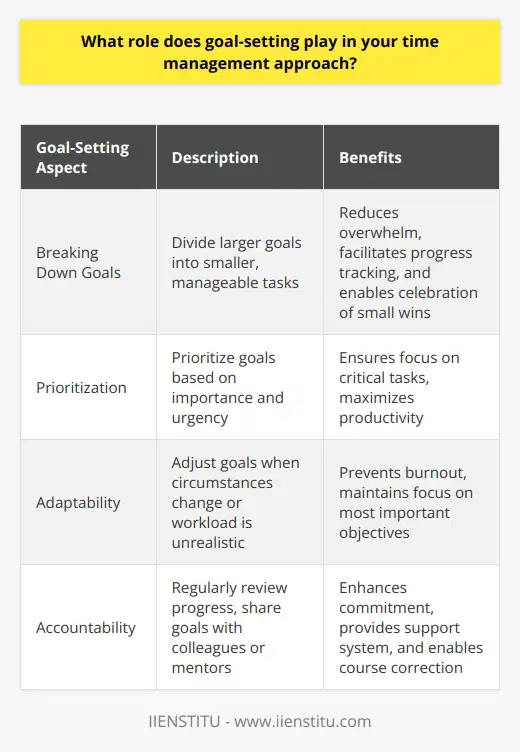
How do you determine the urgency and importance of tasks?
When determining the urgency and importance of tasks, I consider several key factors:
Deadlines and Consequences
I always take into account when a task is due and what the potential consequences of missing that deadline might be. If a project has a tight turnaround time or failing to complete it could significantly impact the company, I prioritize it accordingly.
Alignment with Goals
I evaluate how each task aligns with the overall goals and objectives of my role and the organization. Tasks that directly contribute to achieving key targets or initiatives take precedence.
Stakeholder Needs
I consider who is relying on me to complete the work and how important it is to them. If a task is critical for a high-priority stakeholder like a major client or executive, I make sure to prioritize it.
Interdependencies
Some tasks need to be finished before others can move forward. I look at what downstream work is waiting on my piece and aim to unblock dependent tasks promptly.
Effort vs. Impact
Whenever possible, I try to knock out quick wins first - tasks that can be completed rapidly but will have an outsized positive impact. Then I can devote more time to important work that takes longer.
Ultimately, I aim to stay organized, communicate clearly about my progress and deadlines, and remain flexible to re-assess priorities as needed. I find this approach allows me to consistently deliver on the most critical work.
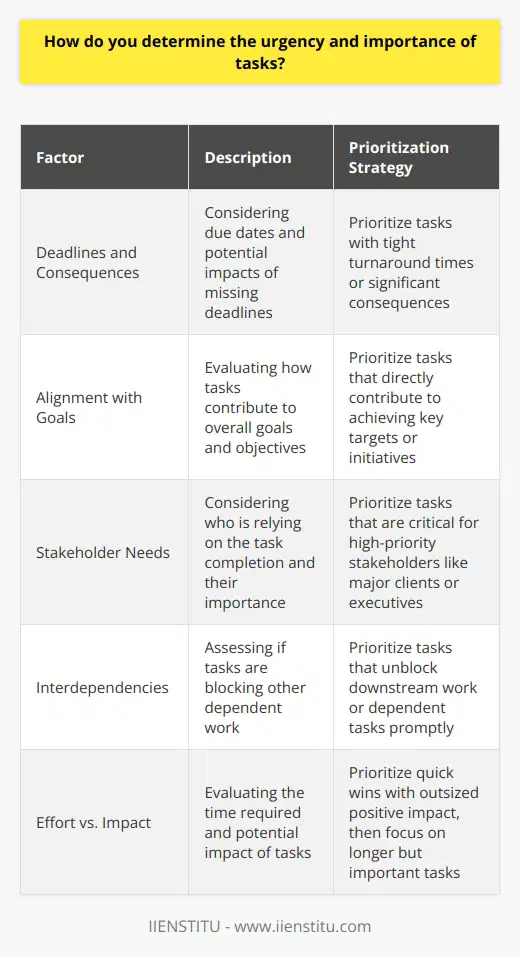
What tools or techniques do you employ to stay organized and on track?
I employ several tools and techniques to stay organized and on track in my work. First and foremost, I rely on a detailed calendar to manage my schedule and deadlines. I find that having a visual representation of my upcoming tasks and appointments helps me prioritize effectively and ensures that nothing falls through the cracks.
Breaking Down Projects
When faced with larger projects, I break them down into smaller, manageable tasks. This approach allows me to focus on one step at a time, reducing overwhelm and increasing my productivity. I use project management software like Trello or Asana to create task lists, set milestones, and track my progress.
Staying Focused
To minimize distractions and maintain focus, I use the Pomodoro Technique. This involves working in focused 25-minute intervals, followed by short breaks. During these intervals, I eliminate all potential distractions, such as silencing notifications on my phone and closing unnecessary browser tabs.
Regularly Reviewing and Adjusting
I make it a habit to review my progress and adjust my plans regularly. At the beginning of each week, I take some time to reflect on the previous week's accomplishments and challenges. I then plan for the upcoming week, prioritizing tasks and setting realistic goals. This regular review process helps me stay aligned with my objectives and make necessary adjustments along the way.
Leveraging Technology
In addition to project management tools, I leverage technology to streamline my workflows. For example, I use cloud storage services like Google Drive or Dropbox to keep my files organized and accessible from any device. I also rely on apps like Evernote or OneNote to capture ideas, meeting notes, and important information in a centralized location.
By employing these tools and techniques, I've found that I'm able to stay organized, prioritize effectively, and consistently meet my deadlines. It's an approach that has served me well in my previous roles and one that I continue to refine and adapt as I take on new challenges.
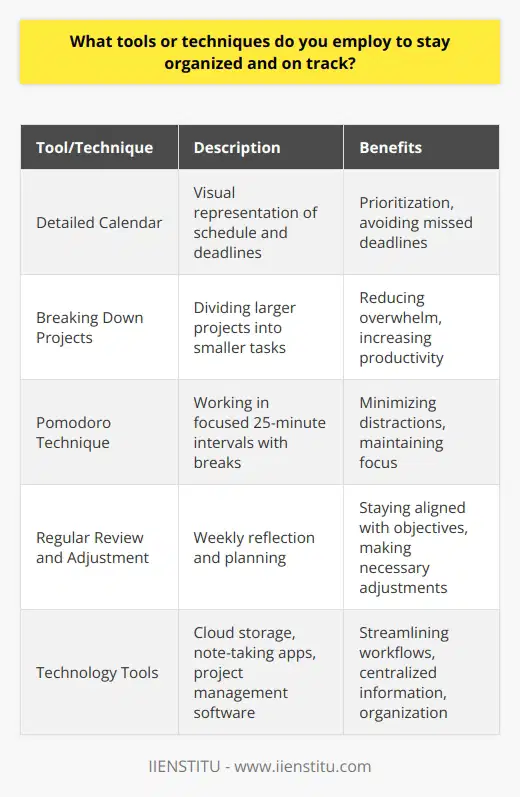
How do you balance short-term and long-term planning in your routine?
I believe that balancing short-term and long-term planning is essential for success in any role. In my daily routine, I strive to prioritize tasks that align with both immediate goals and future objectives.
Prioritizing Daily Tasks
Each morning, I review my to-do list and identify the most critical tasks that require immediate attention. These often include deadlines, urgent requests, and essential meetings. By tackling these short-term priorities first, I ensure that nothing falls through the cracks.
Allocating Time for Long-Term Planning
While addressing short-term needs is crucial, I also dedicate time each week to long-term planning. This involves setting aside dedicated hours to review ongoing projects, assess progress, and make necessary adjustments. By regularly revisiting my long-term goals, I can make informed decisions about resource allocation and adapt to changing circumstances.
Maintaining Flexibility
I've learned that striking a balance between short-term and long-term planning requires flexibility. Sometimes, unexpected challenges or opportunities arise that demand a shift in focus. In these situations, I remain agile and willing to adjust my priorities while still keeping the bigger picture in mind.
Collaborating with Team Members
Effective planning often involves collaboration with colleagues and stakeholders. I make it a point to communicate regularly with my team, sharing updates on short-term progress and seeking input on long-term strategies. This collaborative approach ensures that everyone is aligned and working towards common objectives.
Continuous Learning and Adaptation
To maintain a healthy balance between short-term and long-term planning, I embrace continuous learning. I stay informed about industry trends, best practices, and emerging technologies that could impact my work. By actively seeking opportunities to grow and adapt, I can make more informed decisions and adjust my plans accordingly.
Ultimately, finding the right balance between short-term and long-term planning is an ongoing process. It requires discipline, adaptability, and a willingness to learn from both successes and challenges along the way.
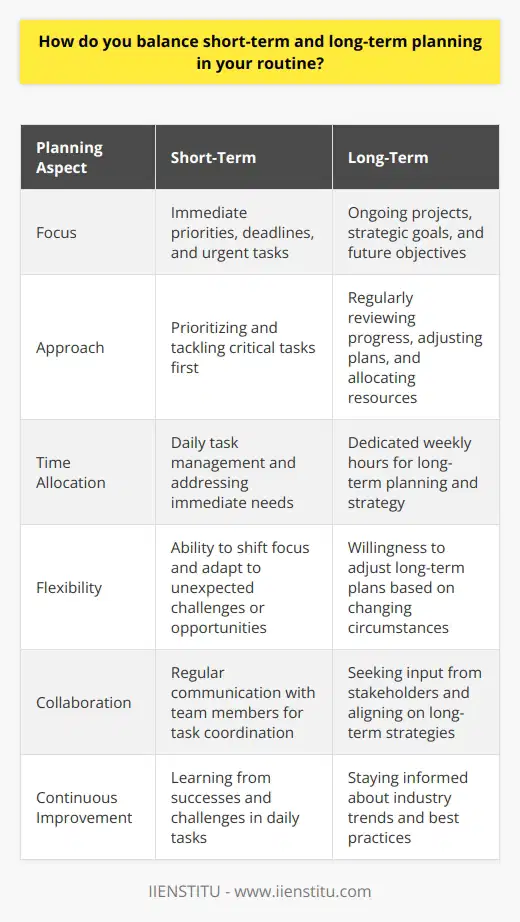
How do you ensure that you allocate sufficient time for high-priority tasks?
I prioritize my tasks based on their importance and urgency. Every morning, I review my to-do list and identify the most critical items that require immediate attention. These are typically tasks that have a significant impact on the company's goals or have tight deadlines.
Blocking Out Time for High-Priority Tasks
Once I've identified the high-priority tasks, I block out dedicated time slots in my calendar to focus solely on them. This ensures that I have uninterrupted periods to make substantial progress on these crucial assignments. I treat these time blocks as non-negotiable appointments with myself.
Breaking Down Complex Projects
When faced with a complex, high-priority project, I break it down into smaller, manageable steps. This allows me to tackle the project in a structured manner and ensures that I allocate sufficient time for each component. By setting mini-deadlines for each step, I can stay on track and avoid last-minute rushes.
Minimizing Distractions
To maximize my productivity during high-priority tasks, I minimize distractions. I silence my phone notifications, close unnecessary browser tabs, and communicate my availability to colleagues. Creating a focused environment helps me concentrate and complete the tasks efficiently.
Regularly Reassessing Priorities
Throughout the day, I reassess my priorities to ensure that I'm always working on the most important tasks. If new urgent matters arise, I adjust my schedule accordingly. This flexibility allows me to adapt to changing circumstances while still dedicating time to high-priority assignments.
By following these strategies, I can consistently allocate sufficient time for high-priority tasks and deliver quality work within deadlines.
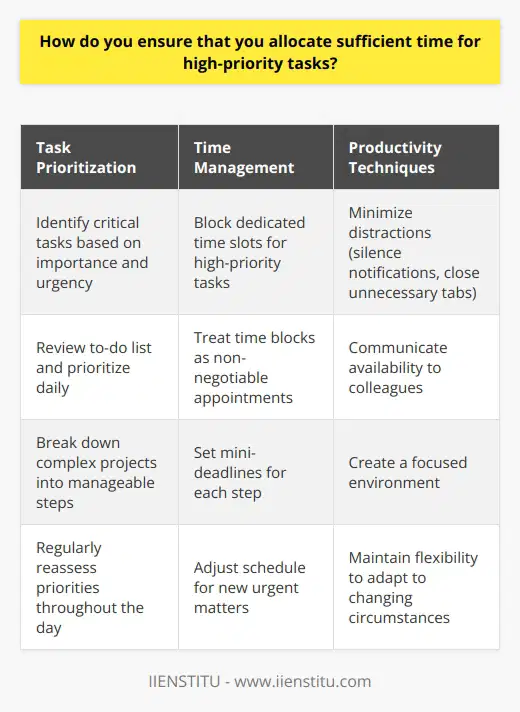
What methods do you use to break down complex projects into manageable tasks?
When faced with a complex project, I break it down into smaller, manageable tasks. This helps me stay focused and motivated throughout the process.
Start with the Big Picture
I begin by looking at the overall goal of the project. What are we trying to achieve? I make sure I fully understand the scope and requirements.
Create a Project Outline
Next, I outline the major components or phases of the project. I consider the logical sequence of steps and dependencies between tasks.
For example, when I was planning my sister's wedding, I broke it down into categories like venue, catering, decor, and entertainment. Then within each category, I listed out the specific tasks that needed to be completed.
Prioritize and Set Deadlines
I prioritize the tasks based on importance and urgency. I set realistic deadlines for each task to keep the project on track.
I remember feeling overwhelmed when I first started planning the wedding. But by focusing on one category at a time and setting mini-deadlines, it became much more manageable.
Delegate and Collaborate
I identify tasks that can be delegated to team members based on their skills and availability. Clear communication and regular check-ins keep everyone aligned.
Planning the wedding was a team effort. I assigned tasks to family members and relied on their support. Collaboration made the process smoother and more enjoyable for everyone involved.
Track Progress and Adjust as Needed
I regularly review progress against the project timeline. If issues arise or priorities change, I adjust the plan accordingly.
There were moments during wedding planning where we had to pivot, like when the outdoor venue fell through. By staying flexible and communicating with the team, we found a great alternative and kept moving forward.
Breaking down complex projects into bite-sized pieces has been a game-changer for me. It reduces stress, improves productivity and helps me deliver high-quality results.
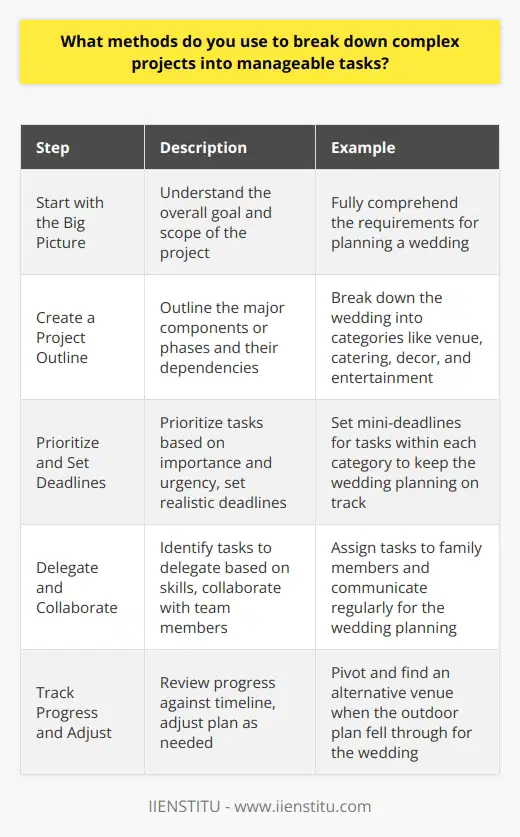
How do you handle procrastination and maintain focus on your plans?
When it comes to handling procrastination and maintaining focus on my plans, I have a few strategies that work well for me.
Prioritize and Break Down Tasks
I start by prioritizing my tasks based on their importance and urgency. This helps me tackle the most critical items first. Then, I break down larger projects into smaller, manageable steps. By doing this, I feel less overwhelmed and more motivated to get started.
Set Realistic Goals and Deadlines
Setting realistic goals and deadlines is crucial for me. I make sure to give myself enough time to complete each task without rushing or compromising quality. When I have a clear timeline in mind, it's easier to stay on track and avoid procrastination.
Create a Supportive Environment
I've found that creating a supportive environment is key to maintaining focus. I minimize distractions by finding a quiet workspace, turning off notifications on my phone, and letting others know when I need uninterrupted time. Sometimes, I even use tools like website blockers to prevent myself from getting sidetracked online.
Take Regular Breaks
Taking regular breaks is essential for me to avoid burnout and maintain productivity. I use techniques like the Pomodoro method, where I work for a set amount of time (usually 25 minutes) and then take a short break. During these breaks, I do something relaxing, like stretching or grabbing a snack. This helps me recharge and come back to my tasks with renewed focus.
Stay Accountable and Celebrate Progress
Finally, I stay accountable by sharing my goals with a trusted friend or colleague. Having someone to check in with regularly keeps me motivated and on track. I also make sure to celebrate my progress along the way, no matter how small. Recognizing my accomplishments helps me stay positive and committed to my plans.
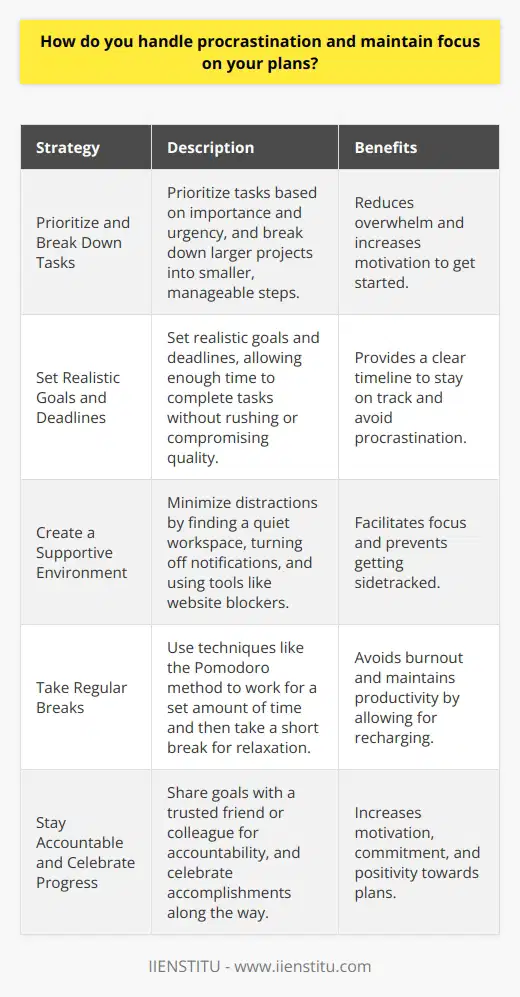
How do you adapt your planning strategy when faced with tight deadlines?
Embrace the Challenge
When a tight deadline comes my way, the first thing I do is get excited. I love a good challenge and the opportunity to push myself to deliver great results under pressure. Sure, it can be a bit stressful at times, but I thrive on that energy and use it to sharpen my focus.
Prioritize Ruthlessly
With limited time, I ruthlessly prioritize my to-do list. I look at the big picture and identify the most critical tasks that will have the greatest impact. Then I put those at the very top and attack them first. The less important stuff gets pushed down or eliminated entirely. There's no time for busywork when the clock is ticking!
Simplify and Streamline
Tight timelines force me to simplify my approach. I strip away anything unnecessary and streamline my efforts. This often leads to creative solutions and more elegant outcomes. As they say, constraints drive innovation. I've had some of my best ideas emerge while working under crazy deadlines.
Collaborate and Communicate
Adapting to tight deadlines isn't a solo sport. I make it a team effort. I clearly communicate the timeline and key priorities to all stakeholders. Then I rally the troops to divvy up tasks and work together to get it done. Frequent check-ins keep everyone on track. And I'm not afraid to ask for help if I need it.
Review and Adjust
Even the best laid plans can go sideways. So I check progress early and often when time is tight. If I see we're falling behind, I quickly re-evaluate and adapt the plan as needed. Flexibility is key. Sometimes that means simplifying scope. Other times it means finding extra resources. But I always keep my eye on the end goal and make smart adjustments to get there.
So while tight deadlines can be intense, I actually find them energizing. They bring out my best - my creativity, my collaboration skills, my laser-focus. And crossing that finish line feels amazing, every time. It's incredibly rewarding to deliver awesome results, even when time is short.
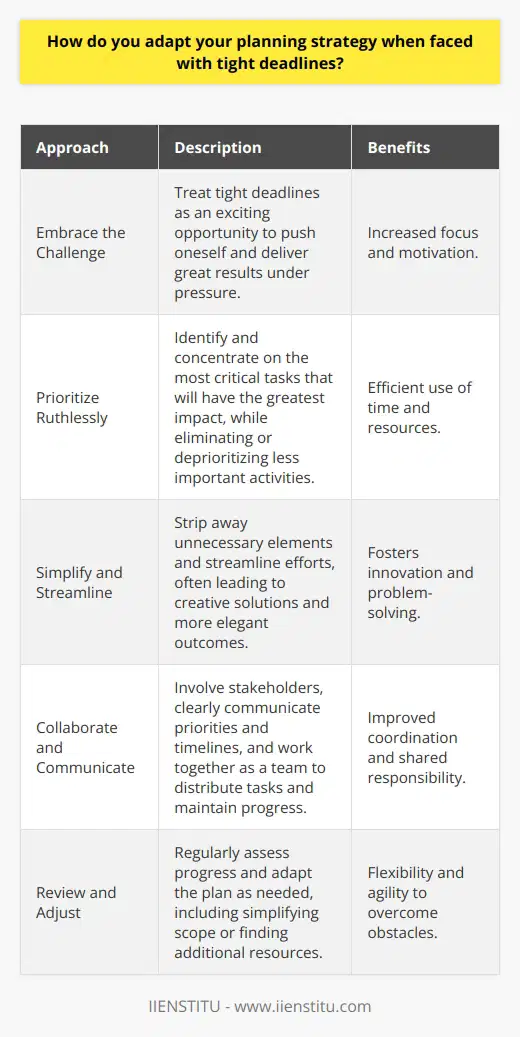
What role does delegation play in your time management process?
Delegation is a crucial aspect of my time management process. As a team leader, I understand the importance of assigning tasks to the right individuals based on their skills and expertise. This allows me to focus on high-priority tasks that require my immediate attention.
Benefits of Delegation
I've learned that effective delegation not only optimizes my own productivity but also empowers my team members. It provides them with opportunities to take on new responsibilities, develop their skills, and contribute to the overall success of the project. By delegating tasks, I can ensure that the workload is evenly distributed and that everyone feels valued and engaged.
Strategies for Successful Delegation
To delegate effectively, I follow a few key strategies:
Balancing Delegation and Accountability
While delegation is essential, I also believe in maintaining accountability. I set up regular check-ins and progress reports to ensure that delegated tasks are on track and meeting the desired standards. This allows me to identify any potential issues early on and provide timely support or course correction if necessary.
In my experience, striking the right balance between delegation and personal involvement has been key to managing my time effectively. It has allowed me to prioritize my own tasks while fostering a collaborative and productive team environment.

How do you incorporate flexibility into your planning to accommodate changes?
When it comes to incorporating flexibility into my planning, I always start by anticipating potential changes and challenges. By considering various scenarios and their impacts, I can develop contingency plans and alternative strategies. This proactive approach allows me to adapt quickly when the unexpected occurs.
Embracing a Growth Mindset
I believe that embracing a growth mindset is key to staying flexible. Instead of seeing changes as obstacles, I view them as opportunities for innovation and improvement. By maintaining an open and curious attitude, I can explore new possibilities and find creative solutions.
Collaboration and Communication
Effective collaboration and communication are essential for navigating changes smoothly. I actively seek input from team members and stakeholders to gather diverse perspectives. By fostering open dialogue and regular check-ins, I can identify potential issues early on and make necessary adjustments to keep projects on track.
Prioritizing and Adapting
When changes occur, I prioritize tasks based on their importance and urgency. By focusing on the most critical aspects first, I can ensure that key objectives are met while remaining flexible in other areas. I also break down larger tasks into smaller, manageable steps, allowing for easier adaptation and course correction as needed.
Continuous Learning and Improvement
I embrace a mindset of continuous learning and improvement. By staying updated with industry trends, best practices, and new technologies, I can identify opportunities to enhance my planning and adapt to changing circumstances. I actively seek feedback, reflect on my experiences, and apply lessons learned to refine my approach over time.
In summary, incorporating flexibility into my planning involves anticipating changes, embracing a growth mindset, collaborating effectively, prioritizing tasks, and continuously learning and improving. By adopting these strategies, I can navigate the ever-changing landscape of projects and deliver successful outcomes, even in the face of unexpected challenges.
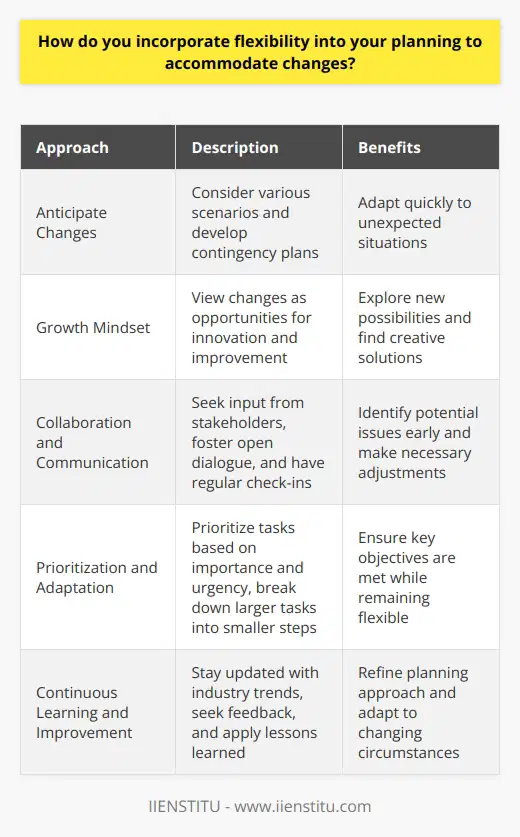
How do you use technology to support your planning and time management efforts?
I rely on various digital tools to effectively manage my time and stay organized. My smartphone is always with me, allowing me to quickly add tasks, appointments, and reminders to my calendar app. This ensures I never miss important deadlines or meetings.
Utilizing Project Management Software
For complex projects, I use dedicated project management software like Trello or Asana. These platforms enable me to break down large tasks into smaller, manageable steps. I can set due dates, assign responsibilities, and track progress in real-time. Collaborating with team members is also seamless, as we can share files, leave comments, and stay aligned on objectives.
Leveraging Cloud Storage and Synchronization
Cloud storage services like Google Drive and Dropbox are essential to my planning efforts. I store all my important documents, spreadsheets, and presentations in the cloud. This way, I can access them from any device, anywhere. Plus, automatic synchronization ensures I always have the most up-to-date versions of my files.
Automating Repetitive Tasks
To save time and streamline my workflow, I automate repetitive tasks whenever possible. For example, I use email filters to automatically sort incoming messages into specific folders. This helps me prioritize my inbox and respond to urgent emails faster. I also leverage automation tools like Zapier to connect different apps and services, eliminating manual data entry and reducing the risk of errors.
By embracing technology, I can plan my days more efficiently, stay focused on high-priority tasks, and ultimately achieve better results in my work.

What strategies do you use to avoid over-planning or under-planning?
I've developed a few key strategies over the years to avoid both over-planning and under-planning. It's all about balance and adaptability.
Set Clear Goals and Priorities
I always start by defining the key objectives and priorities for a project. What absolutely must get done? This helps me avoid getting bogged down in unnecessary details or tangents.
Back when I was planning my best friend's wedding shower, having those clear "must-haves" kept me focused. The venue, invitations, and catering were essential - everything else was bonus.
Create a Flexible Timeline
Once I know the main goals, I map out a general timeline with key milestones. But I build in some wiggle room. Life happens, things change. You need to be able to adapt.
In college, I had to plan a big fundraiser. I had a schedule, but I also had backup plans. When a vendor fell through last-minute, we were able to switch gears without much disruption because I'd anticipated possible roadblocks.
Regularly Reassess and Adjust
Planning isn't a "one and done" thing for me. I'm consistently checking in, seeing how things are progressing, and making adjustments as needed. Regular status checks keep me on track.
Communication is key here too. When I led that big product launch last year, weekly team syncs helped us spot issues early and collaboratively problem-solve. We avoided both scope creep and crucial gaps that way.
So in summary, I aim for that "Goldilocks" planning sweet spot - not too much, not too little, just right. It takes clear goals, flexibility, and consistent recalibration. That's what works for me!
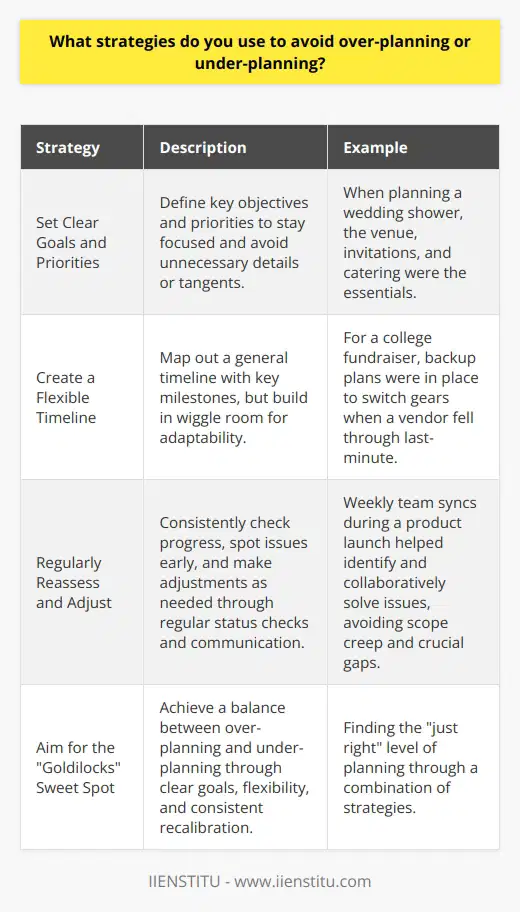
How do you ensure that your planning aligns with your overall goals and objectives?
When planning projects or tasks, I always keep the bigger picture in mind. I start by clearly defining the end goals and objectives, and then work backwards to identify the steps needed to achieve them. This helps me create a roadmap that aligns with the overall vision.
Breaking Down Goals into Actionable Steps
I find it helpful to break down large goals into smaller, manageable tasks. This makes the process less overwhelming and allows me to focus on one step at a time. By doing this, I can ensure that each task contributes to the overall objectives and that nothing is overlooked.
Regularly Reviewing Progress
Throughout the project, I regularly review my progress to ensure I'm staying on track. If I find that I'm veering off course, I take the time to reassess and make adjustments as needed. This helps me stay flexible and adaptable, while still keeping the end goals in sight.
Collaboration and Communication
I believe that collaboration and communication are key to successful planning. I make sure to involve relevant stakeholders and team members in the planning process, seeking their input and feedback. This helps ensure that everyone is on the same page and working towards the same objectives.
In my previous role, I was tasked with planning a major event for our company. I started by sitting down with my manager to clearly define the goals and objectives of the event. From there, I created a detailed plan, breaking down each task and assigning responsibilities to team members. Throughout the planning process, I held regular check-ins to ensure we were on track and making progress towards our goals. Thanks to this collaborative and goal-oriented approach, the event was a huge success and exceeded expectations.
By following these strategies, I'm able to ensure that my planning always aligns with the overall goals and objectives, leading to successful outcomes.
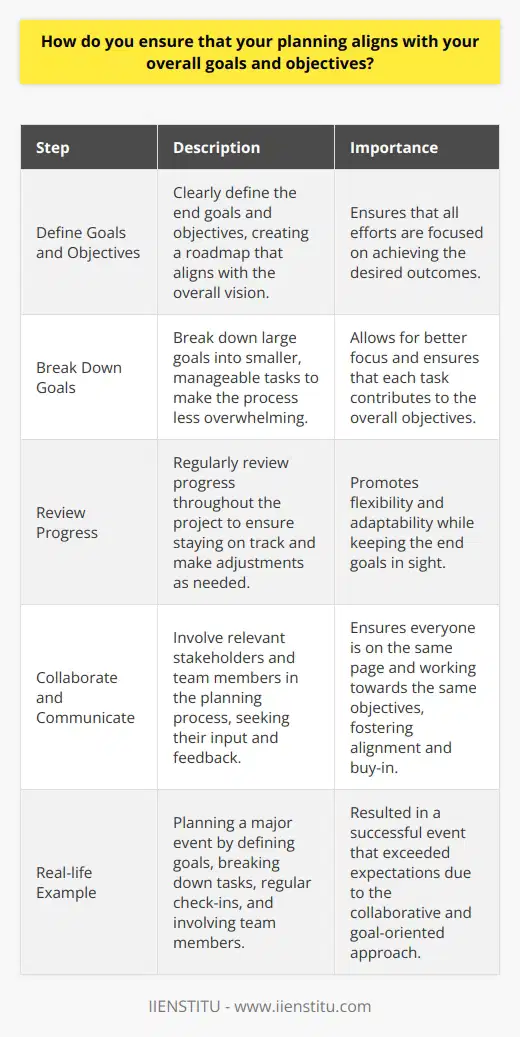
How do you prioritize self-care and breaks in your daily planning?
I prioritize self-care and breaks by setting clear boundaries between work and personal time. This means establishing a consistent schedule that allows for adequate rest and relaxation each day.
Scheduling Self-Care Activities
I make sure to schedule specific self-care activities into my daily routine, such as exercise, meditation, or hobbies. These activities help me recharge and maintain a positive mindset, which ultimately improves my productivity at work.
Taking Regular Breaks
Throughout the workday, I take regular breaks to stretch, walk around, or simply step away from my desk. Even short 5-10 minute breaks can help prevent burnout and maintain focus.
Prioritizing Sleep and Nutrition
I also prioritize getting enough sleep each night and eating a balanced diet. When I'm well-rested and nourished, I'm better equipped to handle stress and make sound decisions at work.
Communicating with Colleagues
Finally, I communicate openly with my colleagues about my self-care needs. If I need to step away for a mental health break or leave early for a doctor's appointment, I make sure to let my team know in advance.
By prioritizing self-care and breaks, I'm able to bring my best self to work each day. It's not always easy, but I've found that investing in my well-being ultimately leads to greater success and satisfaction in my career.
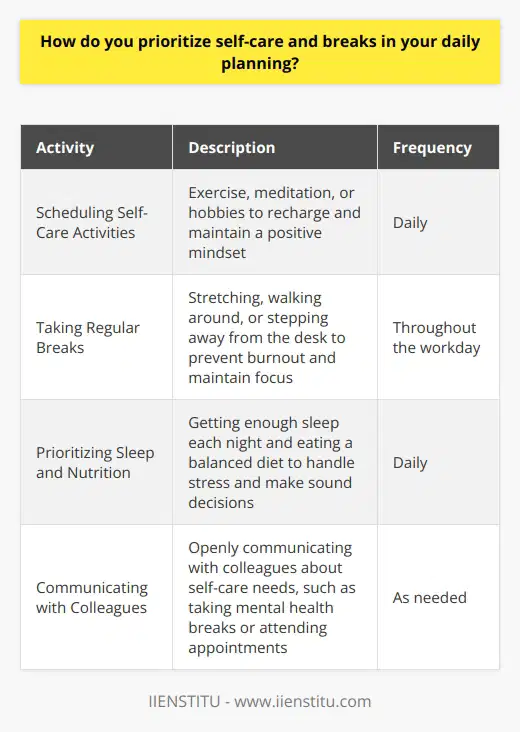
What techniques do you use to estimate the time required for specific tasks?
When estimating the time required for specific tasks, I employ several techniques to ensure accuracy and efficiency. First, I break down the task into smaller, manageable components. This allows me to assess the complexity and duration of each step more precisely. Next, I consider my previous experience with similar tasks and use that knowledge as a reference point. If I've completed a comparable task before, I can gauge how long it might take me this time around.
Consulting with Colleagues
Additionally, I often consult with colleagues who have worked on similar projects. Their insights and suggestions can be invaluable in refining my time estimates. I also factor in potential obstacles or unforeseen challenges that may arise during the process. By anticipating these hurdles, I can build a buffer into my timeline to accommodate any unexpected delays.
Continuous Monitoring and Adjustment
Throughout the task, I continuously monitor my progress and adjust my estimates if necessary. If I find myself ahead of schedule, I may be able to dedicate more time to perfecting certain aspects of the work. Conversely, if I encounter setbacks, I promptly communicate with my team and stakeholders to manage expectations and find solutions.
Leveraging Tools and Resources
Moreover, I leverage various tools and resources to aid in my time estimation process. Project management software, like Trello or Asana, helps me visually map out tasks and deadlines. Time tracking apps, such as Toggl or RescueTime, provide valuable data on how long similar tasks have taken me in the past, allowing me to make more informed estimates in the future.
By employing these techniques and staying organized, communicative, and adaptable, I am able to provide reliable time estimates for specific tasks. This not only helps me manage my own workload effectively but also enables me to contribute to the overall success of the team and the project.
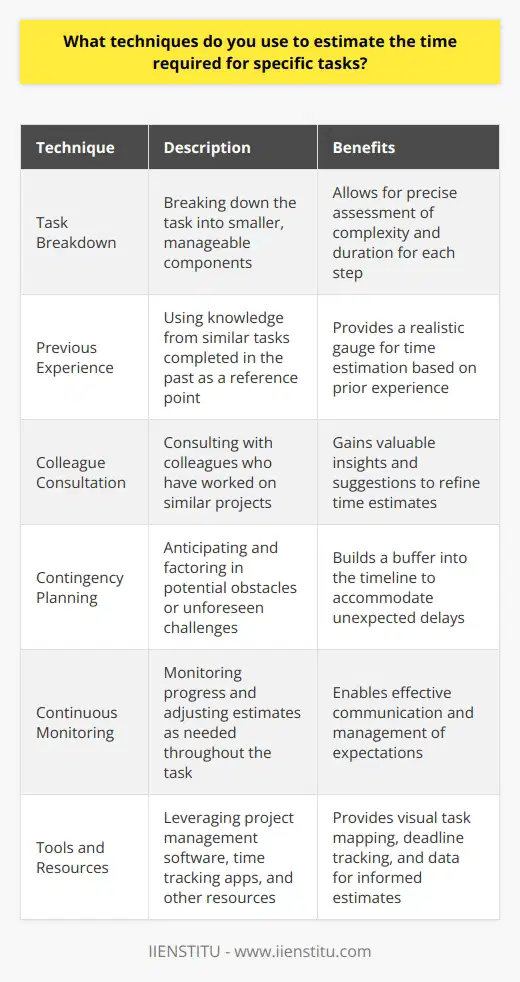
How do you handle situations where your plans are derailed by external factors?
When faced with situations where external factors derail my plans, I remain calm and adaptable. I quickly assess the new circumstances and prioritize the most critical tasks. By focusing on what I can control, I develop a revised plan of action.
Communicating with the Team
I communicate openly with my team about the challenges we face. Together, we brainstorm creative solutions and alternative approaches. Collaboration is key to overcoming obstacles and finding the best way forward.
Staying Positive and Resilient
Throughout my career, I've learned that a positive attitude is essential when plans go awry. I once led a project where a key supplier suddenly went out of business. Instead of getting discouraged, I rallied the team to find new vendors and adjust our timeline. We delivered the project successfully, and I grew as a leader.
Learning from Experience
Every challenge is an opportunity to learn and improve. After navigating unexpected changes, I reflect on what worked well and what could be done differently. By applying these lessons to future projects, I become more resilient and adaptable over time.
In summary, when external factors derail my plans, I stay calm, communicate with my team, maintain a positive outlook, and learn from the experience. I am confident in my ability to navigate challenges and deliver results, even in the face of unexpected obstacles.
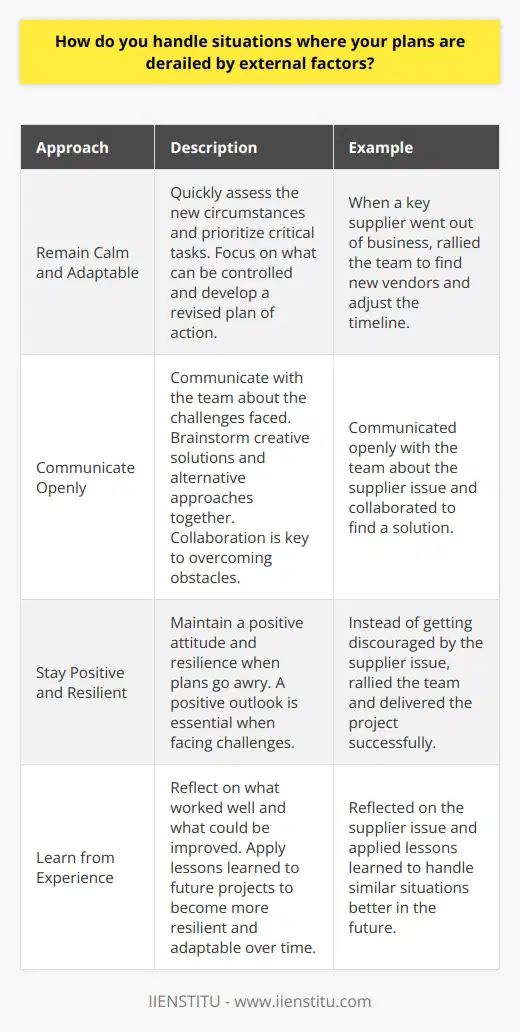
How do you use planning to optimize your productivity and efficiency?
I optimize my productivity and efficiency through careful planning and organization. Every morning, I review my tasks and prioritize them based on urgency and importance. This helps me focus on the most critical tasks first.
Breaking Down Projects
When faced with large projects, I break them down into smaller, manageable steps. By tackling one piece at a time, I avoid feeling overwhelmed and maintain steady progress. I set realistic deadlines for each stage to keep myself on track.
Minimizing Distractions
To maximize my productivity, I try to minimize distractions during work hours. I silence my phone notifications and close unnecessary browser tabs. If I need to concentrate deeply, I sometimes use noise-canceling headphones or work in a quiet room.
Taking Regular Breaks
Although it might seem counterintuitive, taking regular breaks actually boosts my efficiency. Stepping away from my desk for a few minutes helps me recharge and return with fresh eyes. I often take a quick walk or do some stretches to refresh my mind and body.
Leveraging Technology
I'm a big believer in using technology to streamline my workflow. Tools like project management software and time-tracking apps help me stay organized and on schedule. I also automate repetitive tasks whenever possible to free up more time for high-value work.
Continuously Improving
Finally, I'm always looking for ways to optimize my planning and productivity. I regularly reflect on what's working well and what could be improved. By staying adaptable and open to new strategies, I'm able to continuously enhance my efficiency over time.
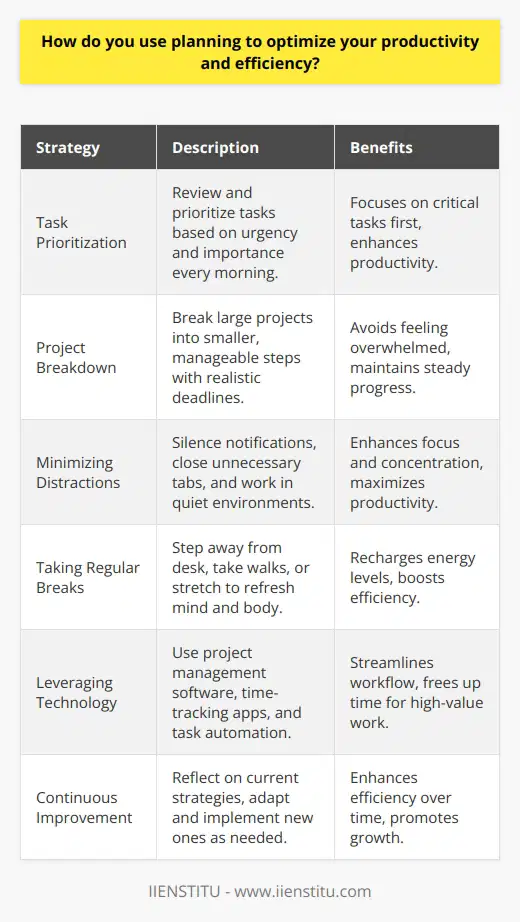
What role does regular review and adjustment play in your planning process?
Regular review and adjustment are crucial components of my planning process. I believe that plans should be living documents, constantly evolving based on new information and changing circumstances.
Continuous Monitoring
I make it a point to regularly monitor the progress of my plans. This allows me to identify any deviations or obstacles early on and make necessary adjustments before they become major issues.
Flexibility is Key
I've learned through experience that being flexible is essential. No matter how well-crafted a plan may be, unexpected challenges can always arise. By remaining open to adjustments, I'm able to adapt quickly and keep projects on track.
Seeking Feedback
I actively seek feedback from colleagues and stakeholders throughout the planning process. Their insights often provide valuable perspectives that I may not have considered, leading to more robust and effective plans.
Lessons Learned
At the conclusion of each project, I conduct a thorough review to identify lessons learned. These insights are then incorporated into future planning efforts, allowing for continuous improvement over time.
In summary, regular review and adjustment are integral to my planning approach. By monitoring progress, remaining flexible, seeking feedback, and learning from past experiences, I'm able to develop plans that are both realistic and effective.
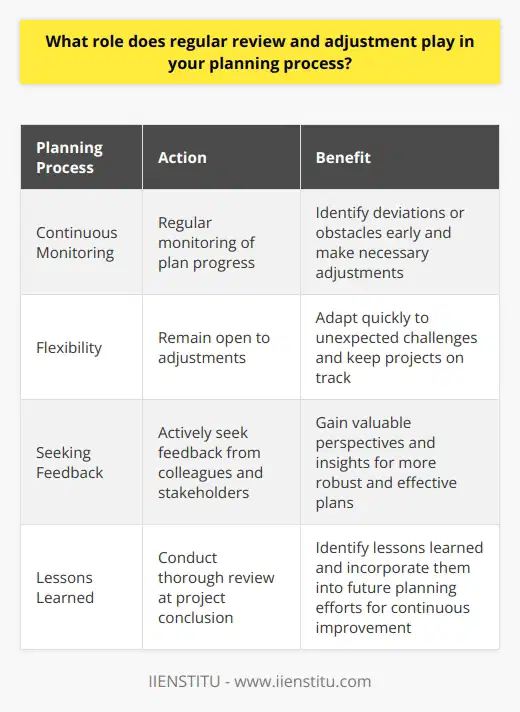
How do you ensure that your planning takes into account potential risks and contingencies?
When it comes to planning, I always consider potential risks and contingencies. It's important to have a backup plan ready, just in case something unexpected happens.
Identify Risks Early
I start by identifying potential risks early in the planning process. This allows me to develop strategies to mitigate or avoid those risks altogether. By being proactive, I can prevent many issues from arising in the first place.
Brainstorm Contingency Plans
Once I've identified the risks, I brainstorm contingency plans for each one. I ask myself, "What will I do if this risk becomes a reality?" Having a clear plan of action helps me stay calm and focused, even under pressure.
Communicate with the Team
I also make sure to communicate my contingency plans with the rest of the team. Everyone needs to be on the same page and know their roles in case we need to pivot. Clear communication is key to executing a successful backup plan.
Stay Flexible
Finally, I stay flexible throughout the process. Even the best-laid plans can go awry, so I'm always ready to adapt as needed. By staying nimble and open to change, I can navigate unexpected challenges with confidence.
In my experience, considering risks and contingencies is a crucial part of effective planning. It's helped me successfully execute projects and achieve goals, even in the face of adversity.
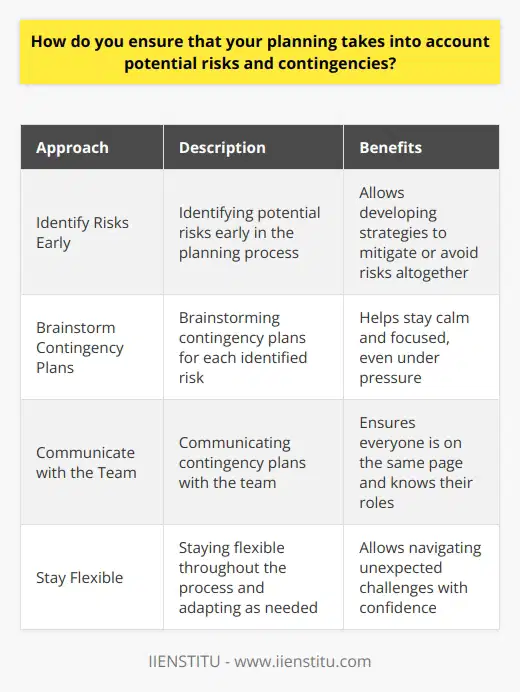
What strategies do you use to avoid over-committing yourself when planning?
When planning, I always start by prioritizing my tasks based on their importance and urgency. This helps me focus on the most critical responsibilities first and avoid overextending myself. I've found that breaking larger projects into smaller, manageable steps is essential for staying on track without feeling overwhelmed.
Effective Communication is Key
Another strategy I use is open communication with my team and superiors. If I feel my workload is becoming unmanageable, I proactively discuss it with them. Together, we can find solutions, such as delegating tasks or adjusting deadlines, to ensure I can deliver quality work without compromising my well-being.
The Power of "No"
I've also learned the importance of saying "no" when necessary. While I'm always eager to take on new challenges, I recognize that taking on too much can lead to burnout and decreased productivity. By being selective about the projects I commit to, I can ensure that I have the time and energy to give my best to each one.
Regularly Reassessing Priorities
Finally, I make it a habit to regularly reassess my priorities and adjust my plans accordingly. Life can be unpredictable, and sometimes unexpected tasks or opportunities arise. By staying flexible and adaptable, I can make room for these changes without over-committing myself or sacrificing the quality of my work.

How do you use planning to maintain a healthy work-life balance?
I believe that maintaining a healthy work-life balance is crucial for both personal well-being and professional success. To achieve this, I rely on careful planning and organization.
Setting Clear Boundaries
First and foremost, I set clear boundaries between my work and personal life. When I'm at work, I focus entirely on my professional responsibilities and give my best effort. However, once I leave the office, I make a conscious effort to disconnect from work-related matters and dedicate my time to personal pursuits and relaxation.
Prioritizing Tasks
I prioritize my tasks based on their importance and urgency. This helps me manage my time effectively and ensures that I allocate sufficient attention to both my work and personal commitments. By tackling the most critical tasks first, I can minimize stress and avoid last-minute rushes.
Scheduling Personal Time
Just as I schedule my work tasks, I also make sure to block off time for personal activities and self-care. Whether it's going to the gym, pursuing a hobby, or spending quality time with loved ones, I treat these activities as non-negotiable appointments in my calendar. This helps me maintain a sense of balance and prevents work from encroaching on my personal life.
Communicating Effectively
Open communication is key to managing expectations and maintaining a healthy work-life balance. I make sure to communicate my availability and any potential conflicts to my colleagues and supervisors. By being transparent about my needs and limitations, I can avoid overcommitting myself and ensure that I have the necessary time and energy to fulfill both my professional and personal responsibilities.
Maintaining a healthy work-life balance requires ongoing effort and adaptability. By setting clear boundaries, prioritizing tasks, scheduling personal time, and communicating effectively, I strive to achieve a harmonious balance that allows me to thrive both professionally and personally.
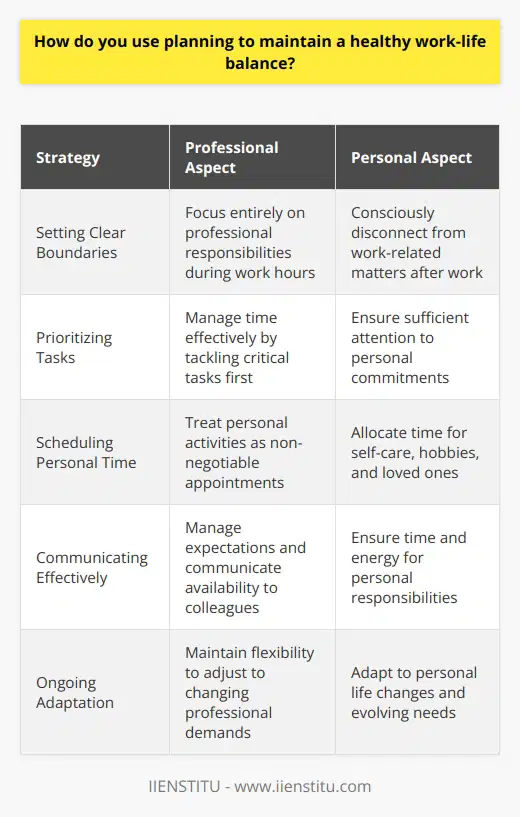
What role does collaboration and communication play in your planning process?
Collaboration and communication are essential elements in my planning process. When working on a project, I always make sure to involve all relevant stakeholders from the beginning.
Involving the Team
I believe that every team member has unique insights and perspectives that can contribute to the success of a project. By actively seeking their input and feedback, I can create a more comprehensive and effective plan.
For example, in my previous role, I was tasked with planning a major event for our company. I started by gathering the entire team and facilitating a brainstorming session where everyone could share their ideas and concerns. This collaborative approach allowed us to identify potential challenges and come up with creative solutions together.
Communicating Clearly and Consistently
Throughout the planning process, I prioritize clear and consistent communication. I make sure to keep all team members informed about progress, changes, and expectations. This helps maintain alignment and ensures everyone is working towards the same goals.
I also believe in the importance of active listening. When collaborating with others, I pay close attention to their thoughts and feelings, asking clarifying questions when needed. This helps build trust and fosters a positive working relationship.
Adapting to Feedback
Finally, I view planning as an iterative process. I'm always open to feedback and willing to adapt my plans as needed. If a team member raises a valid concern or suggests a better approach, I'm happy to incorporate their input.
By remaining flexible and responsive, I can create plans that are not only well-thought-out but also have buy-in from the entire team. This collaborative and communicative approach has been key to my success in previous roles, and I'm excited to bring these skills to this new opportunity.
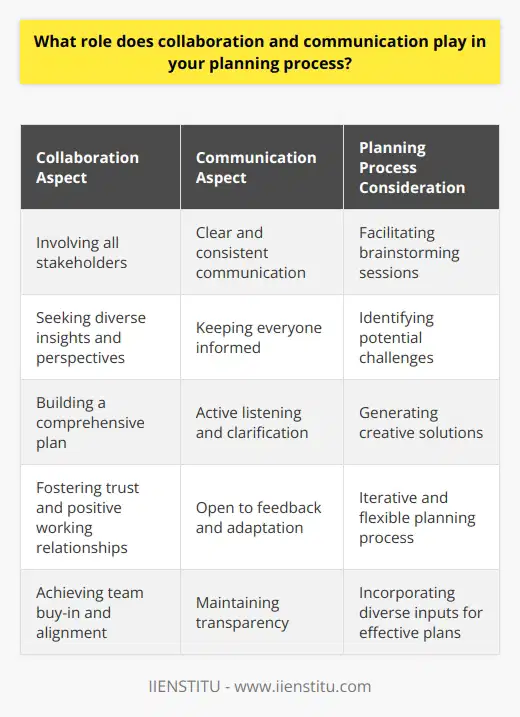
How do you ensure that your planning is realistic and achievable?
When it comes to planning, I always start by breaking down the project into smaller, manageable tasks. This allows me to set realistic timelines and allocate resources effectively. I also make sure to factor in some buffer time for unexpected challenges or delays.
Collaboration is Key
I believe that collaboration is essential for successful planning. I actively seek input from my team members and stakeholders to ensure that everyone is on the same page. By involving others in the planning process, I can identify potential roadblocks early on and come up with creative solutions together.
Prioritizing and Adapting
Another important aspect of my planning approach is prioritization. I focus on the most critical tasks first and make sure that they align with the overall goals of the project. However, I also understand that plans can change, and I'm always ready to adapt and adjust as needed.
Monitoring Progress
Throughout the project, I consistently monitor progress and compare it against the plan. If I notice any deviations or potential issues, I quickly address them and make the necessary adjustments. Regular check-ins with my team also help me stay on top of things and ensure that everyone is moving in the right direction.
At the end of the day, I believe that realistic and achievable planning comes down to a combination of clear communication, flexibility, and a focus on results. By following these principles, I've been able to consistently deliver successful projects in my previous roles.
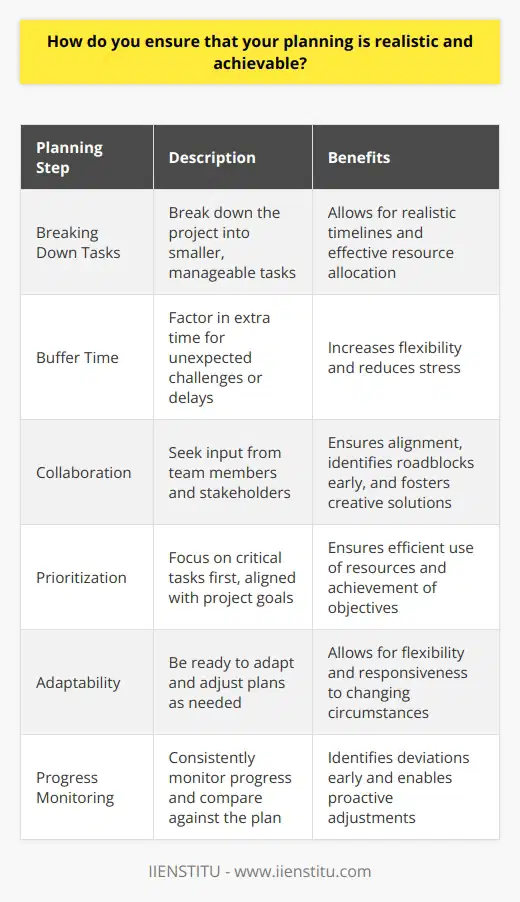
What techniques do you use to stay motivated and committed to your plans?
I use several techniques to stay motivated and committed to my plans. First and foremost, I set realistic goals for myself. I break down larger objectives into smaller, manageable tasks that I can accomplish within a specific timeframe. This approach helps me avoid feeling overwhelmed and allows me to celebrate small victories along the way.
Visualizing Success
Another technique I find effective is visualizing success. I take a moment to imagine myself achieving my goals and how it will feel. This mental exercise creates a positive mindset and reinforces my determination to stay on track. When I encounter challenges or setbacks, I remind myself of the end goal and the satisfaction I'll experience when I reach it.
Accountability and Support
I also believe in the power of accountability. I share my plans with trusted friends or colleagues who can offer support and encouragement. Knowing that someone else is invested in my success adds an extra layer of motivation. We regularly check in on each other's progress, celebrate milestones together, and provide constructive feedback when needed.
Rewarding Myself
To maintain my commitment, I incorporate rewards into my plan. When I achieve a significant milestone or complete a challenging task, I treat myself to something I enjoy. It could be as simple as indulging in my favorite dessert or taking a well-deserved break to pursue a hobby. These rewards serve as a reminder that hard work pays off and motivate me to keep pushing forward.
Continuous Learning
Finally, I embrace continuous learning as a way to stay motivated. I actively seek opportunities to expand my knowledge and skills related to my goals. Attending workshops, reading relevant books, or engaging with mentors keeps me inspired and excited about the possibilities that lie ahead. By investing in my personal and professional growth, I maintain a fresh perspective and find new sources of motivation along the way.
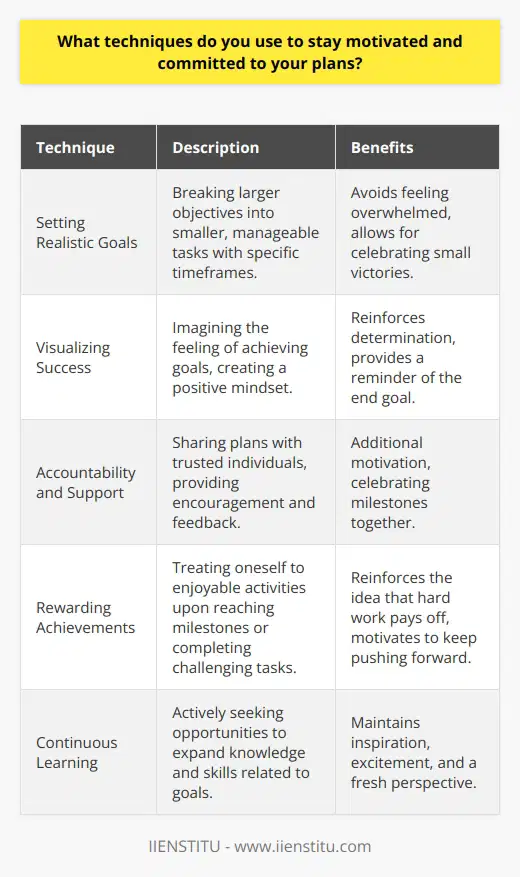
How do you incorporate learning and skill development into your planning?
I actively seek out opportunities to learn and develop my skills, both on the job and in my personal life. Whenever I start a new project or take on a new responsibility, I make it a point to identify areas where I can grow and improve. I'm always looking for ways to challenge myself and expand my knowledge base.
Continuous Learning
I believe that learning is a lifelong journey. I'm constantly reading industry blogs, attending webinars, and participating in online courses to stay up-to-date with the latest trends and best practices in my field. I find that this helps me bring fresh ideas and perspectives to my work.
Skill Development Planning
When I'm planning my professional development, I like to set specific, measurable goals for myself. I break these goals down into smaller milestones and create a timeline for achieving them. This helps me stay focused and motivated, even when I'm faced with challenges or setbacks.
Seeking Feedback
I also make it a habit to seek out feedback from my colleagues and supervisors. I find that getting an outside perspective can help me identify blind spots in my own performance and find new ways to improve. I'm always open to constructive criticism and use it as an opportunity to grow.
Applying New Skills
Of course, learning new skills is only half the battle. I also make sure to actively apply what I've learned to my work. Whether it's experimenting with a new software tool or trying out a different approach to problem-solving, I'm always looking for ways to put my new knowledge into practice.
At the end of the day, I believe that investing in my own learning and development is one of the best things I can do for my career. It helps me stay engaged, motivated, and prepared for whatever challenges come my way.

What role does reflection and self-evaluation play in your planning process?
Reflection and Self-Assessment Are Key
Reflection and self-evaluation play an essential role in my planning process. I find it critical to step back and carefully consider what is working well and what could be improved. This allows me to make adjustments and optimize my approach for better outcomes.
Learning from Successes and Failures
I try to reflect on both successes and failures in an honest way. When something goes well, I assess the key factors that led to that result so I can replicate them in the future. If a project doesn't meet expectations, rather than being discouraged, I view it as a valuable learning opportunity. I consider what I could have done differently and how I can apply those lessons moving forward.
Seeking Input and Feedback
In addition to my own self-evaluation, I find tremendous value in seeking input from colleagues and mentors. Their outside perspective can reveal blind spots and opportunities that I may have missed on my own. I'm always eager to hear feedback, even if it's constructive criticism, because I know it will help me grow and improve my planning and execution.
Continuous Reflection and Iteration
Ultimately, I view planning as an ongoing process of reflection, evaluation, and refinement. By consistently assessing my own performance and gathering feedback, I'm able to iterate and optimize my approach. This allows me to tackle new challenges with greater insight and deliver better results over time.
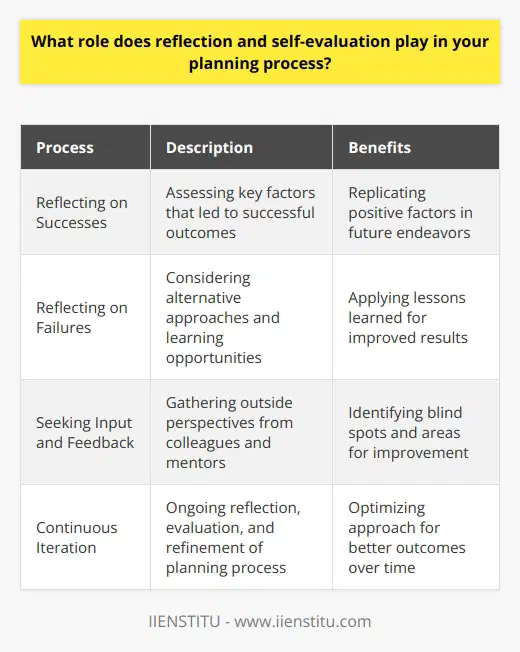
How do you use planning to foster a sense of control and reduce stress?
I believe that effective planning is essential for maintaining a sense of control and reducing stress in both personal and professional life. By breaking down large tasks into smaller, manageable steps, I can prioritize my responsibilities and allocate my time efficiently. This helps me stay focused and avoid feeling overwhelmed by the complexity of a project.
Setting Clear Goals
When I plan, I start by setting clear goals for myself. I ask myself, "What do I want to achieve?" Whether it's completing a specific task or reaching a long-term objective, having a well-defined target keeps me motivated and on track.
Breaking Down Tasks
Once I have my goals in place, I break them down into smaller, actionable steps. This makes the overall task feel less daunting and allows me to make steady progress. I find that crossing items off my to-do list gives me a sense of accomplishment and boosts my confidence.
Prioritizing and Time Management
Effective planning also involves prioritizing tasks based on their importance and urgency. I use tools like calendars and productivity apps to manage my time effectively. By allocating specific time slots for each task, I can ensure that I'm making the most of my day and avoiding unnecessary stress.
Flexibility and Adaptability
While planning is crucial, I also recognize the importance of being flexible and adaptable. Life can be unpredictable, and unexpected challenges may arise. When this happens, I reassess my priorities and adjust my plan accordingly. Being open to change helps me stay resilient and maintain a sense of control even in the face of adversity.
Conclusion
In summary, I believe that effective planning is a powerful tool for fostering a sense of control and reducing stress. By setting clear goals, breaking down tasks, prioritizing responsibilities, and remaining flexible, I can navigate even the most challenging situations with confidence and ease.
